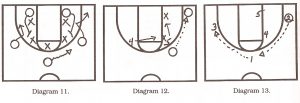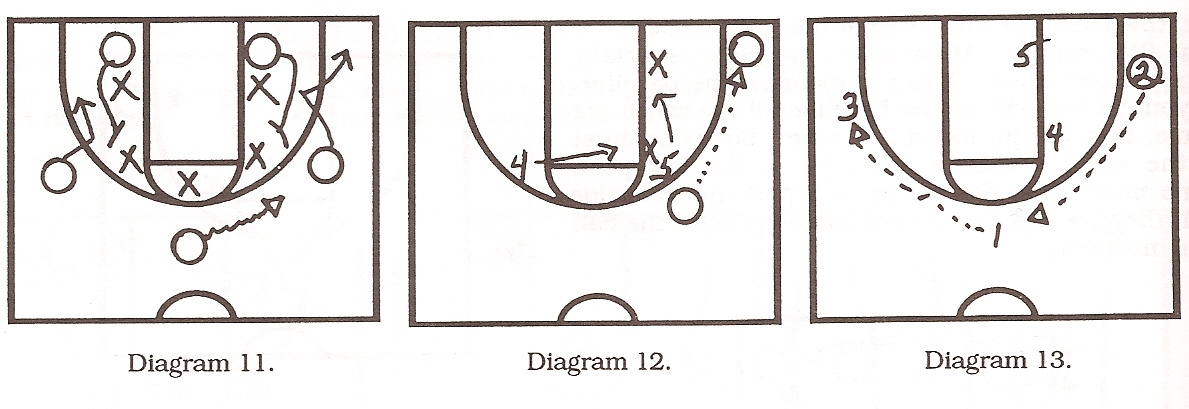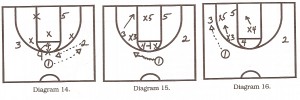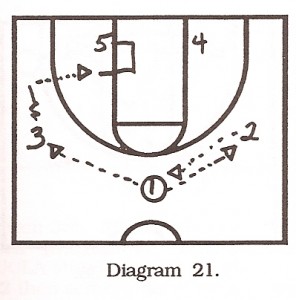
From a clinic presentation by Pete Gillen
Match up is a zone with man to man principles. The man is as important as the ball. The defense will take the shape of the offensive set.
The purpose of a matchup is to get you confused, indecisive, and out of sync. Attacking it is 80% mental. We are going to run the offense that we want to run and act rather than react.
Our ten Principles for attacking the matchup.
1. Attack the zone with the fast break. The fast break is the toughest thing to defend in basketball.
2. Send cutters through. Cutters cause confusion as to who is guarding the cutter. If you just stand, you are doing the matchup a favor.
3. Attack the baseline and then reverse the ball to the other side’s baseline. When the ball is on the baseline, all zones become 2-3s.
4. Dribble penetration. I asked Don Casey, who was a great zone coach, what hurt his zones the most. His answer was dribble penetration. You must work at dribble penetration against a zone in practice. You need to use the dribble after several passes that stretch the zone first. Our rule is that anytime we catch the ball at the point from the wing, that player must penetrate as deep as he can and look to pass to the post or wing.
5. Screen the wings. (Diagram 11) The point guard must dribble at our wing players. Those wing players fade to the corner. That puts pressure on the back man in the zone. Does he stay in our play the man in the corner?
(Diagram 12) If we make the pass to the corner, 5 rolls to the basket and 4 fills the high post, so we have a quick 2 on 1 on the back of the zone with the corner and 5
(Diagram 13) If the corner passes back to the point, the ball is reversed to 3
6. Screen the point. (Diagram 14). 1 passes to 2 and 4 screens the point. Diagram 15 shows the ball being passed back to the point. We run a screen and roll with 4 and 1. 3 fades to the baseline. 1 can take the jumper, dribble into the gut of the zone and pass to 3, if X3 comes up to stop the drive. Or, he can pass to 5 as shown in diagram 16. If we pass to 3 in the corner, X5 must cover him, so 5 comes across the lane. X3 is coming to 3. X5 must either play 5 or 4 because of the high/low situation.
7. We also like to screen in the block area (Diagram 17) The defense is matched up, but when the ball is reversed, 4 screens the back of thd zone. Then 4 ducks in. Don’t flash to the ball unless you screen first (Diagram 18). Have the wing dribble to the corner. Who takes him? 4 comes up the lane. 5 comes behind in diagram 19. Now, we have a box overload. We back-pick with 5 as we step out the 4 and reverse the ball. We send 2 across, but are really looking for 5 ducking in after the screen. Ball goes 2-1-3-2-5.
8. Skip pass after a ball fake. Stretch the zone. You can’t telegraph it, you must freeze the zone.
9. We send four men to the offensive boards because it is difficult for a zone to block out .
10. Duck in and seal back move. 1 to 2 back to 1. 5 ducks in and 1 looks to get the ball to 5. 5 moves the defense by moving several steps along the baseline before ducking in. If we can’t pass to 5, pass to 3. 3 dribbles hard to the baseline and 5 moves outside the lane to receive a bounce pass from 3. The ball goes 1-2-1-3-5.
The Coaching Toolbox has hundreds of resources for coaching basketball including basketball practice, basketball plays, basketball drills, basketball quotes, basketball workouts, basketball poems, and more!










